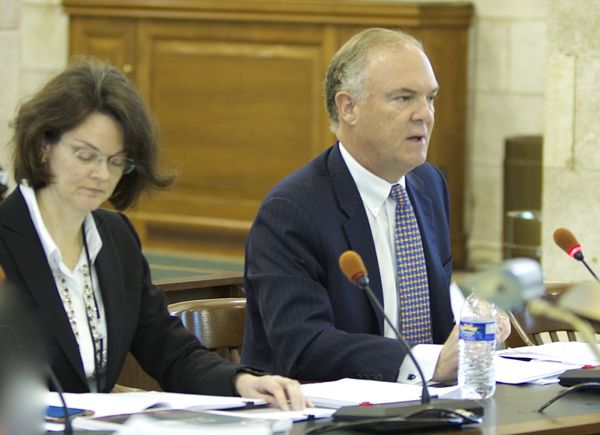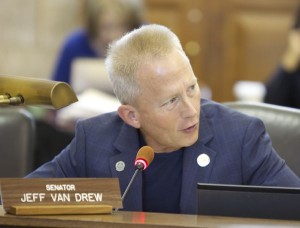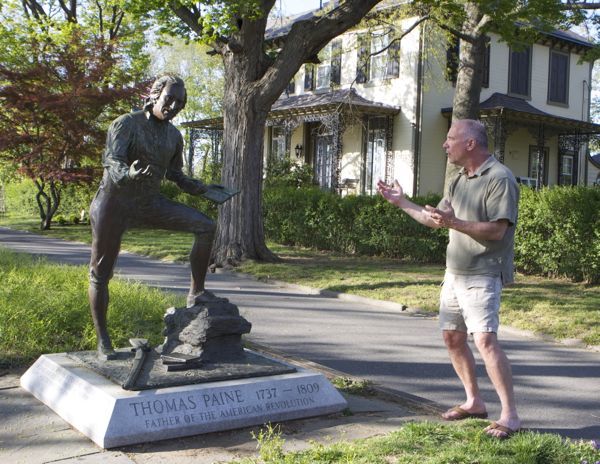DEP Budget Hearing – Martin Bobs & Weaves; No Blows Landed By Dems
Senator Barnes Blasts Commissioner Martin on Exxon Settlement
Martin Refuses to Answer Exxon Questions or Provide Details on NRD Program
Budget Restores Damaging Deep Cuts Created By Open Space Ballot Question

DEP Commissioner Bob Martin testifies to Senate Budget Committee – Adrian Kreke (ph?) Chief Financial Officer (on left) Can someone please tell Martin not to use the water bottles? (4/16/15)
[Update below]
DEP Commissioner Bob Martin presented Governor Christie’s proposed FY’16 DEP budget today to the Senate Budget Committee.
Before we discuss what went down, for those interested, here are the key documents:
- State Budget
- OLS Analysis of DEP’s Budget
- DEP Response to OLS Questions
- DEP Commissioner Martin’s testimony
- Listen to the hearing
Here are the key issues that were discussed today – I’ll be very brief because I’ve written about most of this stuff and folks that want a blow by blow they can listen to the tape (link above). Disappointed that very little press in attendance – only one!
- Restoring Cuts Due to Open Space Ballot
For those who are either in denial about the chaos created by the Keep It Green (KIG) Open Space Ballot Question or legitimately still seem to not understand the dual problem effecting the DEP budget and the Open Space fund allocation, you no longer need to take my word for it, Commissioner Martin highlighted the problem at the outset of his testimony:
Get that? Is it sufficiently clear? If not, let me repeat:
… because the shift in CBT allocation as authorized by the voters, the Administration had to move money around to avoid damaging cuts to several environmental programs.
Martin’s oral testimony was even more stark, which I present in some detail:
Mr. Chairman, I want to address the challenges faced by DEP following the passage of the Constitutional amendment last year, which changed the dedication of the Corporate Business Tax (CBT) revenues.
As you know, the amendment shifted the allocation of a dedicated 4% CBT funding within the environmental categories.
It took money away from such vital programs as the publicly funded hazards waste site cleanups and from water resource management, shifting those funds to acquisition and stewardship of open space, farmland and historic preservation.
.. we do not want to lose money in these programs of water and publicly funded cleanups.
To prevent that from happening, the administration structured this budget proposal within the parameters of that [CBT] amendment. …
We accomplish this by using CBT funds designated for stewardship to fund the operation and management of our parks and wildlife management areas, as well as providing much needed resources for capital investments.
I believe that this is both fiscally responsible and consistent with the language of the [CBT] amendment.
I’ve been saying this for many months, but if the Christie DEP – who seeks to downsize DEP – is complaining of “damaging cuts to environmental programs”, you can be damn sure those cuts are real.
Amazingly – for those that still may not understand this – those “damaging cuts to environmental programs” – were caused by conservation and environmental groups, who never told the voters about any of that in their $1 million propaganda campaign in support of the open space ballot amendment.
Equally important is the fact that because DEP had to restore those cuts, that’s why there is significantly less money available for open space, historic preservation, and farmland preservation programs.
That is another fact and major strategic mistake that the KIG coalition refuses to own up to and take responsibility for. The public still knows very little about this and the press continues to fail to report it.
- Climate Change Denial
Senator Greenstein chastised Martin for abolishing the DEP Office of Climate Change, abandoning work by prior Administrations on climate emission mitigation planning and adaptation, and noted that NJ was the only state on the Atlantic coast that does not have a Climate Adaptation Plan. She asked Martin point blank: what is the State doing to address sea level rise and climate change?
Martin immediately angrily shot back, in a totally inappropriate manner, attacking the questioner:
Well, can I guess who the question came from?
Yeah Bob, I’ve been writing about that for years now. So has the NJ and national press corps. It is a fact, dude.
But that did not stop Martin from spinning a response, that bordered on incoherent babble:
There is no Office closed around climate change, or whatever. We still have our Office of Sustainable Resources within DEP – part of that continues to look at and monitor everything from carbon emissions and everything that’s around that, so, we continue to do those activities.
Not really. The rest of his response was lame.
- EXXON NRD Settlement
Chairman Sarlo gently questioned Martin’s comparison of Exxon to other NRD cases and his claim that Exxon was the largest NRD settlement ever. He asked about why all the gas stations were included. And opposed diversion of the Passaic settlement.
Senator Barnes was much more aggressive and focused in his questioning and he absolutely blasted Martin (see Politicker NJ story: Barnes blisters Martin on Senate Budget Committee
Barnes gets an A for effort, but he really didn’t land a good punch on the merits.
Senator Greenstein noted the difference between restoration and remediation and pressed Martin about the work that will not get done because of receiving just $225 million of $8.9 billion in NR damage. She questioned Martin’s inclusion of the 860 gas stations.
Martin gets an F – he was highly evasive and got testy.
Martin used the excuse of pending litigation to avoid answering questions – that is pure bullshit, because he and the Attorney General issued a press release praising the deal and, as Senator Barnes noted, the Settlement is now open for public comment.
- Regulatory Relief – 200 Cases Settled by DEP Office of Dispute Resolution
Senator Oroho (R-ALEC) asked Martin the typical red meat regulatory question.
Martin gave the administration’s stock spin on bureaucratic streamlining and cutting “job killing red tape” (Martin was able to steer clear of these slogans that have been used to support his policies).
But he did note something new of significance: Martin said 200 cases had been settled by his Alternate Dispute Resolution program. That Office cuts deals on disputes involving DEP permit conditions and enforcement actions.
It is a back door for polluters to negotiate behind closed doors and cut sweetheart deals with DEP political appointees that they can’t get with DEP regulators and professionals.
We previously tried to find out what was going on in that Office, but DEP denied out OPRA request, see: DEP Dispute Resolution – Deals Done in the Dark
Perhaps an intrepid reporter might want to file and OPRA and see what those 200 deals look like – we’re sure there’s not another Exxon.
- Van Drew Promotes Pinelands Pipeline & South Jersey Economic Development
Senator Greenstein asked Martin about his views on the Pinelands pipeline by South Jersey Gas.
Martin replied that he supported the pipeline and that he submitted a DEP letter in support of the pipeline.
I didn’t know this and find it very inappropriate for an Agency head to be lobbying on behalf of a regulated entity’s project before another regulatory agency.
Martin’s view is that the pipeline would be good for the environment – i.e. that the route was along existing ROW, only a handful of trees would be taken, re-powering BL England would provide air quality improvements, and there is a need for new energy source in South Jersey. He sounded like the lobbyists for SJG!
He then supported fracking too.
Later, Senator Van Drew was smoking the crack pipe. He was pushing the SJG Pinelands pipeline, defending the Millville Durand tract deal, and supported all sorts of south jersey development and fisheries concerns. To his credit, he did seek more DEP resources and help on Delaware Bay.
DEP Commissioner Martin was very friendly in response. Martin knew more details about fishing pots and reefs than the Exxon deal.
- Liberty State Park
Senator Cunningham presssed Martin on DEP’s Liberty State Park plans, and specifically asked when DEP would release the $120,000 consultant’s Report on privatization and commercialization of the park.
Martin refused to make a commitment about when he would release the Report, defended the Governor’s “Sustainable Parks Strategy”, and downplayed privatization concerns.
But Cunningham made it very clear that this was an important issue for her and her constituents.
- Millville – Durand Tract
Senator Barnes asked a good question from Emile DeVito of NJCF about the Millville Durand tract Green Acres deal.
For details on that, see: Christie DEP Blasted For Open Space Land Diversion “Perversion”
Martin was unfamiliar with it and spoke in broad strokes about a “deal”.
Senator Van Drew jumped in to defend the deal and promote economic development.
Conclusion
Other than a few sparks from Senators Barnes and Greenstein, the hearing was just a song and dance, with little likely to come from it.
I got no sense that the Democrats would fight for any of the policy or budgetary issues they tepidly raised.
Other than Barnes, there was no umbrage taken by Martin’s multiple manipulations and spin – and very few followup questions to challenge him.
The OLS analysis and questions to DEP were not focused on the policy or performance of the DEP, so legislators were poorly prepared.
Environmentalists were present, but appeared to have little influence on the Democrats (other than Greenstein) and the Republicans were just AWOL (with the exception of Bucco, who jumped in to defend Martin on Exxon).
There was only one state press corps present, Phil Gregory, so I guess the DEP is just not on the political or policy radar of NJ media.
Sad.
(and it appears that KIG has had a bad influence on Barnes and Greenstein, in particular regarding the definition of “stewardship” and denial about the DEP program cuts caused by the ballot question).
[PS – a legislative insider told me this:
When Phil Gregory is the only press guy here, you know that you’re fucked ]
[Update: 4/17/15 – NJ Spotlight drank the KIG Kool-aid. Or is it the Foundation grant money?
Spotlight used the DEP Senate budget hearing – where at least a dozen controversial and newsworthy issues were discussed – to write about just one issue: open space (read the story here).
They spun that issue as a “diversion” of open space funds, and framed the story exclusively from the perspective of the Keep It Green Coalition, providing no conflicting facts about how the open space ballot diverted existing CBT revenues for core DEP programs: State Parks; water resources; and toxic site cleanup.
Here is Scott Olson’s comment on the Spotlight story, which says it better than I have:
Tom Gilbert’s statement “If the will is there, they could find it in another way’’ is completely disingenuous. The same could have been said about the open space funding…if there was a will, there was a way it could (and SHOULD) have been done without screwing over State Parks funding, historic preservation funding, or the numerous DEP clean water & public health programs that were robbed by a million-dollar disinformation campaign waged by ‘Keep It Green’ on the November ballot question. Well meaning people who are now finding out that when they voted ‘Yes’ on Open Space, they also voted to defund these programs are now enraged – while Gilbert and his merry band of thieve continue their attempts to raid the fund for ‘stewardship’ dollars for their own elitist organizations. Shame on them.






